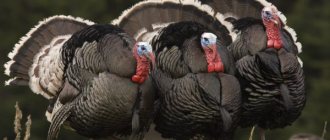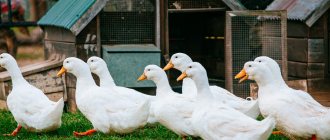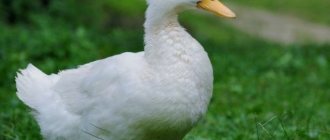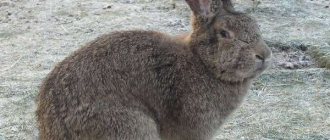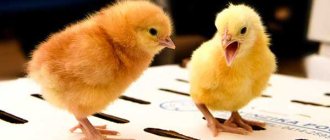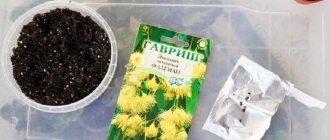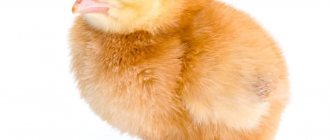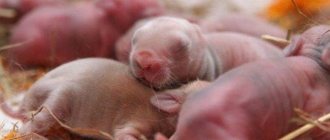Features and description of broiler ducks
All existing breeds of broiler ducks are hybrids. Their ancestors are the Indian duck and the Peking duck. Both parent breeds have disadvantages: Peking ducks have too fatty meat, noisy behavior and a tendency to gluttony; Indo ducks have low adaptability to temperature conditions, and the meat tastes like wild meat, which not all gourmets like. Breeders managed to minimize the above-mentioned disadvantages in hybrids.
The weight of broiler ducks grows quickly; in a short time, the duckling turns into an adult, looks large and well-fed. Many farmers manage to raise 2 or 3 offspring per season.
Broiler ducklings are killed before 7 months of age, before the molting period. At this age, feathers change from chick feathers to hard ones, which negatively affects the quality of meat products. And the appetite of teenage broilers increases; their further maintenance simply becomes unprofitable.
Popular breeds
There are up to 10 different breeds of broiler-type ducks found on farms. Among them are Peking broiler duck, as well as a number of new crosses: Agidel, Cherry Valley, Mulard, etc. Each breed has a different set of characteristic qualities.
Musk American
This type of broiler has a characteristic musky odor secreted by special glands. Because of this, the carcasses of slaughtered poultry emit an odor similar to the smell of the meat of wild relatives. The body weight of an adult drake can reach 6-7 kg, ducks weigh a little less - 3-4 kg. Broiler meat is characterized by dietary properties, it is not fatty and tasty.
“Americans” fly mainly in spring and summer. The maximum number of eggs per season is about 120 pieces. The eggs are white and weigh about 70 g. The musk duck is unpretentious in its maintenance and does not require the construction of an artificial pond. Broilers do not respond well to low room temperatures. Farmers will still have to take care of building a warm barn before the cold weather arrives.
Visually, the breed is distinguished by the reddish tint of the skin around the eyes and beak. Drakes have characteristic folds and red bumps on their heads. It is impossible to hear the usual quack of musk ducks; usually this bird gives its voice in the form of a characteristic hiss.
White Pekingese
The weight of the Peking duck varies between 3-3.5 kg, males of this breed reach 4.5-5 kg. The mass of eggs is 20 g more than that of the “American” ones. The average egg production is about 120 eggs throughout the year.
Visually, the white broiler duck has a powerful build and a large head. The birds have flattened beaks that are orange in color. The legs are short, wide, the neck is shortened, the plumage is of increased density.
The breed is distinguished by its accelerated growth rate and unpretentious maintenance (can be raised without a reservoir). To obtain lean meat, breeders slaughter poultry in the second month of life.
The Beijing dog's diet should contain predominantly protein foods. Feeding must be organized throughout the day, because... the bird is characterized by a fast metabolism.
Agidel
Ducks of the Agidel breed are capable of reaching significant body weight. The cross is endowed with good immunity and is unpretentious in maintenance. An adult reaches a weight of up to 3-4 kg.
A distinctive feature of the birds is their high egg production among other broilers. A duck can lay more than 200 eggs per year. Agidel has not lost the ability to hatch eggs, demonstrating high productivity. A bird can hatch up to 50 eggs at a time. The survival rate of young animals is about 98%.
Representatives of the breed can be raised both in pens and on free range. Birds are unpretentious in feeding; they do not require food with a high calorie content.
Ducks love water, so drinking bowls constantly filled with water are a must for keeping a broiler.
Cherry Valley
According to its characteristics, it is as close as possible to its ancestor - the white Beijing broiler. This type of bird is characterized by increased growth rates. Provided high-quality feeding, the owner can get a carcass weighing 3-4 kg by the end of the third month of life. Poultry meat has a characteristic red hue and has an exquisite taste.
Cherry Valleys are characterized by average egg production, one individual lays up to 150 eggs per year weighing 70-90 g. Ducks of this breed need small bodies of water, where they enjoy swimming in the warm season. Visually, the broiler is similar to the “Beijing”. It has a wide powerful chest, short strong legs, and a convex forehead. Plumage color is white.
Mulard
The Mulard broiler breed was successfully bred by scientists on the basis of American and Peking ducks. The fatty liver of this breed becomes the basis for preparing foie gras.
Already in the third month of life, the weight of an adult reaches 4 kg. The meat has an exquisite taste. Visually, the bird is similar to its ancestor - the Peking duck. However, this breed has a black spot on the top of its head. Broilers do not lay hatching eggs. Eggs laid at home remain sterile.
Mulards have a negative attitude towards low temperatures. Birds can only roam freely during the warm season. When the temperature drops, a coop house with a room temperature of at least 20 degrees will be equipped for them.
Star 53
The breed, bred by French specialists, is distinguished by high growth rates and lean, tasty meat. By the end of the second month of life, the individual gains a weight of 4.5 kg. Birds do not gain excess fat even with abundant and frequent feeding. Equipped with a massive back and elongated body. The bird's chest is wide, slightly protruding. The plumage of Star 53 is slightly yellowish.
Representatives of the cross are sensitive to living conditions. They react poorly to drafts and low temperatures. The optimal value of the latter in the duckling house should be about 18-20 degrees. Temperature changes are undesirable for birds of this breed.
Favorite
Sometimes on domestic farmsteads you can meet representatives of the favorite meat breed or “blue” ducks. The birds got their name due to their characteristic gray-blue plumage. In addition to its visually attractive qualities, the bird is characterized by rapid weight gain - up to 3.5 kg by the beginning of the third month of life.
Pace
Relatively new hybrid. Ducklings of this breed grow quickly and gain weight, reaching 3.5 kg in the second month of life. Duck meat has a rich taste, its fat content is no more than 20%.
Place for maintenance and care
The room for ducks must be dry, spacious, ventilated, and disinfected. Daylight hours should last 10 hours. The optimal temperature is 22-24 °C, air humidity is 65-70%. Overheating and hypothermia lead to weakened immunity. Raising at home requires plenty of space for each bird. When relocating, broilers do not gain weight well. 1 m2 can accommodate 15 month-old ducklings and 6-8 adults.
The bedding is made from straw, hay, sawdust. 12 kg are required per individual for the growing period. The bedding is changed as it gets dirty to prevent infection of the ducks' feet.
It is advisable to raise broiler ducks with the possibility of walking. A fenced walking area is being built. To care for the birds, feeders and drinking bowls are installed on the site, and an artificial pond is built, which must be cleaned regularly.
See also
What mandarin ducks look like and where they live, what they eat and how many years they liveRead
Reviews
According to reviews from experienced farmers, Mularda is the most unpretentious in growing. With any type of feeding, the cross quickly gains weight. Like Musk breeds, Mulards have good health, have a calm disposition, and are quiet. Not suitable for seasonal breeding. Many breeders breed Mulards for their tasty, juicy, tender meat, duck liver.
Due to the high cost of ducklings and the lack of a stable market for meat products, some farmers prefer the Hungarian Pied cross . Representatives of this variety have a lower cost and are not inferior in productivity to Mulards.
The Peking breed has received positive reviews. Ducks grow quickly, gain weight, are distinguished by endurance, and high egg production rates. At 50 days of age they reach four kg. The most intensive growth is observed at 6-8 weeks of age. The meat is juicy, tasty, but fibrous compared to other breeds.
Despite the simple maintenance of broiler duck breeds, in order to raise a healthy poultry population it is necessary to ensure optimal housing and feeding conditions.
By choosing the right balanced diet, you can get meat with excellent taste and nutritional properties and profit from the sale of carcasses. The type of feeding largely depends on whether the ducks are raised for meat or as breeding material for selection.
What do broilers feed?
Private poultry farmers prefer to feed broiler birds with grain and plant foods, while large farmers prefer to feed them with compound feed. Feeding usually continues until 2-3 months, by which time the young individual weighs enough for slaughter.
In the first week, ducklings are given a boiled egg, cottage cheese, millet porridge, and chopped herbs. Beans and grains are gradually introduced into the diet. At 3 weeks, broiler ducklings eat barley, wheat, corn grain, and greens. In the first days of life, broilers grow on protein food (20% of the diet), closer to slaughter the amount decreases to 10%.
Proper diet for broiler ducks:
- grain, bran – 45%;
- greens – 40%;
- beans – 10%;
- shell rock, chalk – 2%;
- garden additives (zucchini, pumpkin) – 2%;
- fish oil – 1%.
Birds grazing near a pond willingly eat duckweed.
When grown on compound feed for up to 3 weeks, starting and then finishing nutrition is used. Recommended daily servings:
- 1st week – 95 g;
- 2nd – 105;
- 3rd – 155;
- 4th – 205;
- 5th – 215;
- 6th – 250;
- 7th – 255;
- 8th – 260.
Feeding
For the full growth and development of the bird, it is advisable to immediately establish an optimal feeding regime. Hatched ducklings must be fed no later than the first 15 hours of life.
For these purposes, finely chopped boiled eggs and starter feed are used. In the first few days, the young animals are fed 8 times a day. Then the number of feedings is reduced to 4 times a day. From the second or third week of life, chopped nettle, dandelion, etc. greens are added to the food.
After 20 days, the ducks begin to eat feed. For full development, premixes, bone meal, and other mineral supplements are introduced into the birds’ diet. Boiled vegetables, chopped greens are additional nutrition and delicacy for the bird.
Nuances of breeding
Only purebred ducks are bred. When breeding 2nd generation individuals, ducklings with blurred breed qualities appear. For breeding, a group of 4 females and 1 drake is created. If the ducks' maternal instinct has not atrophied, then a secluded place with a nest is prepared for incubation. You can take a wooden box. It is enough to place the egg on the ground. The female herself drags straw and blades of grass into the nest and sits on the eggs until all the ducklings peck.
If the female refuses motherhood, she will have to use an incubator. Eggs are rejected by candling, disinfected, placed in an incubator, kept at a temperature of 37.8 °C, humidity 60-70%.
When to score
In the case of broiler ducks, this entirely depends on the tastes of the owner. Ducks grow up to 2 months, after which they begin to gain fat. If you need a carcass without fat with thin skin, the duck is slaughtered at 2 months.
Attention! When plucking, the skin may tear.
If you need a duck with a stronger skin and a small layer of fat, you should feed the duckling up to 3-4 months. But here another problem arises: juvenile molting. When slaughtering a duck older than 2 months, you must be prepared for the fact that it has begun juvenile molting and after plucking there will be a lot of feather stumps left in the skin.
Mulards and Muscovy ducks can be kept for up to 5 months. They don’t gain fat, but they have time to shed.
What diseases are they susceptible to?
Broilers are susceptible to infection and unfavorable external factors; they often develop diseases:
- conjunctivitis and ulceration of the mucous membranes due to retinol hypovitaminosis;
- convulsions, bradycardia due to tocopherol hypovitaminosis;
- colds, viral infections;
- intestinal infections;
- level disease due to mineral deficiency (birds begin to eat inedible objects);
- cuticculitis is a deficiency of retinol and B vitamins, accompanied by diarrhea and exhaustion.
Prevention of the listed diseases consists of maintaining cleanliness and order in the poultry house, proper and balanced feeding, good ventilation, and regular disinfection.
